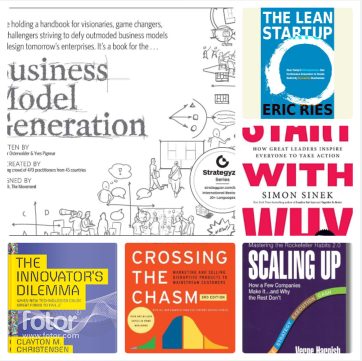
Startup Launch: A Practical Guide To Launching Your Own Business
Note: A Free Edition of our “Startup Launch: A Practical Guide To Launching Your Own Business” e-book will be available to download in PDF format …Soon!
Starting a business is not for the faint of heart, it’s like jumping off a cliff and building a plane on the way down. But, have no fear!
With the right tools and knowledge, You’ll be soaring above the clouds in no time. In this post, we’ll be diving into the must-read book for any aspiring entrepreneur, “Startup Launch: A Practical Guide To Launching Your Own Business”.
This guide is like having a personal startup Sherpa, guiding you through the treacherous terrain of market research, business planning, and funding.
You’ll learn how to create a unique value proposition that’ll make your competitors green with envy, Develop a marketing strategy that’ll have customers lining up at your door and prepare for launch day like a boss.
So strap in, grab a cup of coffee and let’s get started on making your startup dreams a reality!
We’ll be covering the following areas “Post to be updated periodically”:
I. Introduction
A. What is a startup
A startup is a company or organization that is in the early stages of business, typically characterized by high uncertainty and risk.
Startups are often created by entrepreneurs with a vision of creating something new and innovative. They are typically small and agile, with a focus on rapid growth and scalability.
Actually, many known startups were born to solve certain problems that its founders faced or wanted to build a solution for.
B. Importance of having a clear vision and goal
Having a clear vision and goal is crucial for the success of any startup. A vision is a long-term view of what the company hopes to achieve, while a goal is a specific, measurable objective that the company aims to reach.
Having a clear vision and goal helps to provide direction and focus for the company, and helps to align the efforts of all team members towards a common goal.
C. Overview of the book
This book is designed to provide a comprehensive guide to starting a successful startup. It covers all aspects of the startup process, from conducting market research and developing a business plan, to securing funding and building a team.
The book is intended for entrepreneurs, startup founders, and anyone interested in starting their own business. Throughout the book, readers will find practical tips, real-world examples, and helpful resources to guide them on their startup journey.
II. Conducting Market Research
A. Understanding the Industry
Before starting a business, it is essential to have a thorough understanding of the industry in which you plan to operate.
This includes understanding the overall market size, growth trends, key players, and any regulatory or legal requirements.
This research should also include an analysis of the target customer demographic, including their needs, preferences, and buying habits.
In many cases, entrepreneurs learnt while they grew their startups. Learning is an ongoing process, just do your basic research, start and you’ll keep learning and developing it over time.
B. Identifying Customer Needs
Once you have a clear understanding of the industry, the next step is to identify the specific needs of your target customers.
This may involve conducting surveys, focus groups, or interviews to gather information about what customers are looking for in a product or service.
It’s also important to stay up-to-date with the latest industry trends and customer needs, so that you can adapt your product or service accordingly.
C. Analyzing the Competition
In addition to understanding the industry and identifying customer needs, it’s also important to analyze the competition.
This includes researching the products, services, and marketing strategies of your competitors, as well as identifying their strengths and weaknesses.
By understanding the competitive landscape, you can make strategic decisions about how to differentiate your product or service and position your business for success.
D. Developing a Unique Value Proposition
Once you have a clear understanding of the industry, customer needs, and the competitive landscape, you can then develop a unique value proposition.
A unique value proposition is a statement that clearly communicates the unique benefits of your product or service and how it addresses the needs of your target customers.
A strong unique value proposition is essential for differentiating your business from the competition and for effectively communicating the value of your product or service to potential customers.
In summary, conducting market research is an essential step in the startup process.
By understanding the industry, identifying customer needs, analyzing the competition, and developing a unique value proposition, you can make informed decisions about your business and position it for success.
III. Developing a Business Plan
A. Outlining the Company Structure
When it comes to building a successful business, having a solid foundation is essential. In this section, we will explore the importance of outlining the company structure in your business plan.
- Defining Roles and Responsibilities: Clearly define the roles and responsibilities of each member of your team. Outline the organizational structure, including key positions and reporting relationships.
This helps establish a sense of clarity and accountability within your company.
- Team Composition: Identify the skills and expertise required for each position in your company. Assess whether you have the right people in place or if additional hiring or training is necessary.
Building a strong team is crucial for the success of your business. Invest in your team but don’t get consumed by it. - Legal Structure: Determine the legal structure of your company, whether it’s a sole proprietorship, partnership, limited liability company (LLC), or corporation.
Consider the advantages and disadvantages of each structure and select the one that aligns best with your long-term goals.
B. Financial Projections
No business plan is complete without accurate and realistic financial projections. In this section, we will discuss how to develop financial projections that demonstrate the viability and potential profitability of your business.
- Sales Forecast: Estimate your expected sales revenue based on market research, customer analysis, and pricing strategies. Consider factors such as seasonality, market trends, and potential growth opportunities.
Your sales forecast will be the foundation for other financial projections. - Expense Projection: Identify and estimate all the costs associated with running your business, including operational expenses, marketing and advertising costs, employee salaries, and overhead expenses.
Ensure that your expense projection is comprehensive and reflects the true financial requirements of your business. - Profit and Loss Statement: Create a profit and loss statement that outlines your projected revenue, expenses, and net income over a specific period, usually for the first three to five years.
This statement provides a clear picture of your business’s financial health and its ability to generate profits. - Cash Flow Projection: Develop a cash flow projection that tracks the inflow and outflow of cash in your business.
This projection helps you anticipate any cash shortages or surpluses, enabling you to make informed financial decisions and manage your cash flow effectively.
C. Marketing Strategies
In today’s competitive landscape, effective marketing strategies are vital for attracting customers and generating sales.
This section will delve into various marketing strategies that will help you promote your products or services and differentiate your business from competitors.
- Target Market Analysis: Identify and understand your target market—the specific group of customers you aim to serve. Conduct market research to gather valuable insights about their needs, preferences, and behaviors.
This analysis will guide your marketing efforts and ensure you tailor your messaging accordingly. - Branding and Positioning: Develop a strong brand identity that resonates with your target market. Create a compelling brand story, design a memorable logo, and establish a consistent visual and verbal brand language.
Position your business in a way that sets it apart from competitors and appeals to your target audience. - Marketing Channels: Determine the most effective marketing channels to reach your target market.
This could include a mix of digital marketing (websites, social media, email marketing), traditional advertising (print, radio, television), and other promotional activities such as events or collaborations. - Marketing Budget: Allocate a budget for your marketing activities, ensuring you allocate resources wisely to maximize your return on investment. Consider the cost-effectiveness and reach of different marketing channels and monitor the performance of your marketing campaigns regularly.
By outlining the company structure, developing accurate financial projections, and implementing effective marketing strategies, you lay a strong foundation for your business’s success.
This chapter equips you with the necessary tools and knowledge to create a comprehensive business plan that demonstrates your vision and attracts investors, partners, and customers.
So, let’s roll up our sleeves and build a roadmap that leads your business to prosperity!
D: Developing a Sales and Distribution Plan
A well-defined sales and distribution plan is crucial for driving revenue and ensuring your products or services reach the right customers.
In this section, we will explore the key components of developing a robust sales and distribution plan.
- Sales Strategy: Define your sales approach and strategy. Determine whether you will employ a direct sales model, where your team directly engages with customers, or an indirect sales model, where you utilize distributors, retailers, or online platforms.
Consider the pros and cons of each approach based on your target market, product complexity, and competitive landscape. - Sales Channels: Identify the most effective sales channels for your business. This could include a combination of online sales, brick-and-mortar stores, partnerships with distributors or wholesalers, or a direct sales force.
Evaluate each channel’s reach, cost-effectiveness, and alignment with your target market. - Pricing Strategy: Develop a pricing strategy that reflects the value your product or service offers while remaining competitive in the market. Consider factors such as production costs, profit margins, customer affordability, and perceived value.
Regularly review and adjust your pricing strategy based on market dynamics and feedback from customers and stakeholders.
- Sales Forecast: Estimate your sales volume and revenue projections based on your marketing efforts, market demand, and historical data (if available).
Take into account factors like seasonality, market trends, and potential disruptions that may impact your sales performance.
A realistic sales forecast will help you set targets, allocate resources, and measure your business’s financial success. - Distribution Network: Determine the most efficient and effective distribution network for your products or services.
Evaluate options such as shipping logistics, warehousing, inventory management, and fulfillment centers.
Assess whether you will handle distribution in-house or outsource it to third-party logistics (3PL) providers or fulfillment partners. - Sales Training and Enablement: Invest in training and empowering your sales team with the knowledge, skills, and tools necessary to effectively promote and sell your offerings.
Provide them with product training, sales techniques, and ongoing support to ensure they are equipped to meet customers’ needs and achieve sales targets. - Monitoring and Evaluation: Implement systems to track and evaluate the performance of your sales and distribution efforts.
Utilize key performance indicators (KPIs) such as sales conversion rates, customer acquisition costs, and customer satisfaction levels.
Regularly analyze the data and make adjustments to optimize your sales and distribution strategies.
By developing a comprehensive sales and distribution plan, you create a roadmap for reaching your target customers, driving revenue growth, and expanding your market reach.
Remember to regularly review and adapt your plan based on market trends, customer feedback, and business objectives. With an effective sales and distribution plan in place, you’ll be well-positioned to achieve sustainable business growth and success.
IV. Securing Funding
A. Understanding the Different Types of Funding Available
Securing funding is a crucial step in the startup process, as it allows a business to develop and grow. There are several types of funding available to startups, including:
- Angel investment: This type of funding comes from wealthy individuals, known as angel investors, who provide capital in exchange for equity in the company.
- Venture capital: This type of funding is provided by venture capital firms, which invest in startups with high growth potential in exchange for equity.
- Crowdfunding: This type of funding allows businesses to raise capital by soliciting small investments from a large number of people, usually via the internet.
- Bank loans: This type of funding is provided by banks, and usually requires a collateral and a good credit score from the entrepreneur.
- Government grants: Some government agencies provide grants for startups, usually for specific sectors or for companies that fulfill certain criteria.
B. Exploring Options such as Angel Investors, Venture Capital, and Crowdfunding
Each type of funding has its own set of pros and cons, and it’s important to carefully consider which option is best for your business.
For example, angel investors and venture capital firms often provide more than just capital, they also provide mentorship and valuable industry connections.
On the other hand, crowdfunding is a good option for businesses that have a large customer base or a strong online presence.
C. Creating a Fundraising Strategy
Developing a fundraising strategy is an essential step in securing funding. This includes setting fundraising goals, identifying potential investors, and creating a clear and compelling pitch.
It’s also important to have financial projections and a solid business plan in place, as these will be key elements in convincing investors to invest in your business.
D. Tips for Pitching to Investors
Pitching to investors can be a nerve-wracking experience, but there are several things that entrepreneurs can do to increase their chances of success. Some tips include:
- Be prepared: Make sure you have a well-researched and polished pitch, as well as a solid business plan and financial projections.
- Be confident: Investors want to see that you believe in your business and have the ability to execute your plan.
- Be honest: Investors appreciate transparency, so be open and honest about any potential risks or challenges your business may face.
- Be flexible: Be open to feedback and willing to make changes to your plan based on input from investors.
- Follow up: After the pitch, make sure to follow up with investors to keep them updated on your progress and to answer any questions they may have.
In summary, securing funding is a crucial step in the startup process. By understanding the different types of funding available, exploring options such as angel investors, venture capital and crowdfunding, creating a fundraising strategy and following some tips for pitching to investors, you increase the chances of success in getting the funding needed for your startup.
V. Building a Team
A. Recruiting and Hiring Employees
Recruiting and hiring employees is an essential step in building a successful startup. The right team can make or break a business, so it’s important to take the time to find the right people for the job.
This includes identifying the skills and qualifications needed for each role, as well as the company’s values and culture.
There are several ways to recruit and hire employees, such as:
- Posting job listings on job boards and social media.
- Networking and reaching out to potential candidates.
- Hosting job fairs and events.
- Partnering with recruitment agencies.
B. Creating a Strong Company Culture
Creating a strong company culture is essential for attracting and retaining top talent, as well as for building a cohesive and motivated team.
A strong company culture is one that aligns with the company’s values and mission, and that fosters a sense of community and shared purpose among employees.
This can be achieved by promoting open communication, creating opportunities for employee engagement and feedback, and encouraging collaboration and teamwork.
C. Managing and Leading a Team
Managing and leading a team is a critical aspect of building a successful startup. This includes setting clear goals and expectations, providing regular feedback and coaching, and creating opportunities for professional development.
It’s also important to foster a positive work environment, where employees feel valued and respected, and to recognize and reward outstanding performance.
D. Building a Diverse and Inclusive Team
Building a diverse and inclusive team is essential for a startup’s success. A diverse team brings in a variety of perspectives and ideas, which can lead to innovation and improved decision making.
An inclusive team, on the other hand, ensures that everyone feels valued and respected, and that their unique contributions are recognized.
This can be achieved by actively recruiting from underrepresented groups, promoting diversity and inclusion in the hiring process and creating a culture where all employees feel included and respected.
In summary, building a team is an essential step in the startup process.
By recruiting and hiring employees, creating a strong company culture, managing and leading a team and building a diverse and inclusive team, you can ensure that your startup has the right people in place to drive success.
VI. Launching
A. Preparing for Launch Day
Preparing for launch day is an essential step in the startup process. This includes finalizing all product or service details, creating a launch plan and testing all systems to ensure they are functioning properly.
It also includes preparing all marketing and communication materials, such as press releases, social media posts, and email campaigns.
Additionally, it’s important to create a detailed launch timeline outlining all the tasks that need to be completed and the people responsible for them.
B. Establishing a Launch Plan
Creating a launch plan is an essential step in the launching process. It includes identifying the target audience, setting launch goals and determining the budget for the launch.
Additionally, it’s important to identify the key metrics that will be used to measure the launch’s success, such as website traffic, social media engagement, and sales.
The launch plan should also include a detailed timeline of all the tasks that need to be completed, along with the people responsible for them.
C. Building Buzz and Generating Interest
Building buzz and generating interest is an essential step in the launching process.
This includes creating a comprehensive marketing and communication plan, developing a content strategy and leveraging social media and other online channels to reach the target audience.
It also includes reaching out to influencers and media outlets to generate coverage and building relationships with key industry players.
D. Evaluating the Launch and Making Adjustments as Necessary
Evaluating the launch and making adjustments as necessary is an essential step in the launching process.
This includes analyzing the data collected during the launch, such as website traffic, social media engagement, and sales. Based on the data, it’s important to identify what worked well and what didn’t.
It also includes making necessary adjustments to the product or service, marketing and communication strategies, and overall business plan as needed.
In summary, launching a startup is an exciting and critical step in the startup process.
By preparing for launch day, establishing a launch plan, building buzz and generating interest, and evaluating the launch and making adjustments as necessary, entrepreneurs can increase their chances of success and ensure that their startup gets off to a strong start.
VII. Scaling and Growth
A. Identifying and Addressing Growth Challenges
As a startup begins to grow, it will inevitably face a number of challenges. These can include scaling operations to meet increased demand, managing rapid growth, and maintaining profitability.
It’s important for startups to identify these challenges early on and develop strategies for addressing them.
This may involve seeking out new funding, expanding the team, or re-evaluating the business model.
B. Developing a Scaling Strategy
Once the growth challenges have been identified, the next step is to develop a scaling strategy. This includes identifying the key areas of the business that need to be scaled, such as production, marketing, and sales.
It also involves creating a plan for how these areas will be scaled, including timelines and specific milestones.
Additionally, it’s important to identify any potential bottlenecks that may occur as the business grows and develop strategies for addressing them.
C. Building a Sustainable Business Model
As the business grows, it’s important to ensure that the business model is sustainable. This includes identifying and addressing any financial or operational risks, as well as creating a plan for long-term profitability.
It also involves regularly reviewing and adjusting the business model as needed, to ensure that it remains aligned with the changing market and industry conditions.
D. Preparing for Future Growth
As the business begins to scale, it’s important to prepare for future growth. This includes identifying new markets, developing new products and services, and building a strong brand.
It also involves creating a plan for how the business will handle future growth, including timelines, milestones, and funding requirements.
Additionally, it’s important to continue to invest in the company’s infrastructure, such as technology and people, to ensure that it can support future growth.
In summary, scaling and growth is an exciting and critical step in the startup process.
By identifying and addressing growth challenges, developing a scaling strategy, building a sustainable business model and preparing for future growth, startups can increase their chances of success and ensure that they are well-positioned for long-term success.
It’s important to remember that scaling and growth is an ongoing process, and startups should be prepared to adapt and evolve as needed to stay competitive in the market.
Additionally, it’s important to have a plan in place for how to manage and support the growth, it can be hiring more staff, expanding the office, or investing in new technology.
VIII. Conclusion
A. Summarizing Key Takeaways
Starting a successful startup is a challenging and exciting journey that requires a combination of hard work, dedication, and the right strategies and resources.
Throughout the book, we have discussed various important aspects of the startup process, including conducting market research, securing funding, building a team, launching, scaling, and growth.
We have also provided practical tips, real-world examples, and resources to guide readers on their startup journey.
B. Encouraging Readers to Take Action
Starting a startup is not an easy task but it is a rewarding one. We encourage readers to take action by applying the strategies and resources discussed in the book to their own startup journey.
We also encourage readers to seek out additional resources and support, such as networking with other entrepreneurs, attending industry events, and seeking guidance from experts in the field.
C. Additional Resources for Further Learning and Support
There are many resources available for entrepreneurs looking to start and grow a successful startup.
Some additional resources for further learning and support include:
- Online communities and forums for entrepreneurs.
- Incubators and accelerators for startups.
- Industry associations and networking groups.
- Books, podcasts, and blogs on startup and entrepreneurial topics.
- Government resources and programs for small businesses.
- Consultants, coaches and mentors who specialize in startup and business.

FAQs
Q: What is a startup?
A: A startup is a new company or business venture that is in the process of developing and launching its product or service.
Q: Why is having a clear vision and goal important for a startup?
A: Having a clear vision and goal helps to guide the decision-making process and ensures that the startup is working towards a specific and achievable objective.
Q: What can I expect to learn from this book?
A: This book covers various aspects of the startup process, including conducting market research, securing funding, building a team, launching, scaling and growth.
It also provides practical tips, real-world examples, and resources to guide readers on their startup journey.
Q: What is the purpose of market research?
A: The purpose of market research is to gather and analyze data on a specific market, industry, or target customer, in order to make informed decisions about the business.
Q: How do I identify customer needs?
A: Identifying customer needs may involve conducting surveys, focus groups, or interviews to gather information about what customers are looking for in a product or service.
It’s also important to stay up-to-date with the latest industry trends and customer needs, so that you can adapt your product or service accordingly.
Q: How do I analyze the competition?
A: Analyzing the competition includes researching the products, services, and marketing strategies of your competitors, as well as identifying their strengths and weaknesses.
This helps you to make strategic decisions about how to differentiate your product or service and position your business in the market.
Q: What is a unique value proposition (UVP)?
A: A unique value proposition (UVP) is a statement that clearly communicates the unique benefits of a product or service and how it addresses the needs of target customers.
It helps to differentiate your business from competitors and position your offering in the market.
Q: What are the different types of funding available for startups?
A: The different types of funding available for startups include angel investment, venture capital, crowdfunding, bank loans and government grants.
Q: How do I create a fundraising strategy?
A: Creating a fundraising strategy includes setting fundraising goals, identifying potential investors, and creating a clear and compelling pitch.
It’s also important to have financial projections and a solid business plan in place, as these will be key elements in convincing investors to invest in your business.
Q: What are some tips for pitching to investors?
A: Some tips for pitching to investors include being prepared, confident, honest and flexible.
It’s also important to follow up after the pitch to keep investors updated on your progress and answer any questions they may have.
Q: How do I recruit and hire employees?
A: Recruiting and hiring employees includes identifying the skills and qualifications needed for each role, as well as the company’s values and culture.
This can be achieved by posting job listings, networking and reaching out to potential candidates, hosting job fairs, and partnering with recruitment agencies.
Q: What is the importance of creating a strong company culture?
A: Creating a strong company culture is essential for attracting and retaining top talent, as well as for building a cohesive and motivated team.
A strong company culture aligns with the company’s values and mission, and fosters a sense of community and shared purpose among employees.
Q: How do I build a diverse and inclusive team?
A: Building a diverse and inclusive team includes actively recruiting from underrepresented groups, promoting diversity and inclusion in the hiring process, and creating a culture where all employees feel included and respected.

Quick Final Tips for Starting a Successful Startup:
- Conduct thorough market research to understand the industry and identify customer needs.
- Create a unique value proposition to differentiate your product or service from competitors.
- Develop a solid business plan and financial projections to secure funding and attract investors.
- Build a strong and diverse team with the right skills and values to support the growth of the business.
- Establish a launch plan and generate buzz to increase visibility and attract customers.
- Be prepared to adapt and evolve as the market and industry change, and continuously evaluate and adjust your business model as necessary.
- Utilize the resources and support available such as networking with other entrepreneurs, attending industry events, and seeking guidance from experts in the field.
- Always have a plan for scaling and growth, and be prepared to address any challenges that may arise.
- Create a long-term sustainability plan that addresses any financial or operational risks and ensures profitability.
- Stay focused on your goal and vision, and be persistent in the face of challenges and obstacles.

Recommended Books to Read
In case you missed our Entrepreneur’s Must-read Books List, Here are some books that may be helpful for someone starting a startup:
- “The Lean Startup” by Eric Ries: This book provides a framework for developing and launching a successful startup by focusing on rapid experimentation and continuous iteration.
- “Start with Why” by Simon Sinek: This book explains how successful companies and leaders start with a clear sense of purpose and inspire others to follow their lead.
- “The Innovator’s Dilemma” by Clayton Christensen: This book explores how disruptive innovations can challenge established businesses and provides insights on how companies can stay ahead of the curve.
- “Crossing the Chasm” by Geoffrey Moore: This book provides a framework for understanding how to market and sell disruptive products and services to mainstream customers.
- “Business Model Generation” by Alexander Osterwalder and Yves Pigneur: This book provides a visual toolkit for creating and communicating business models and includes a wide range of real-world examples.
- “The Startup Owner’s Manual” by Steve Blank and Bob Dorf: This book provides a step-by-step guide to building a successful startup and includes practical tools, templates and case studies.
- “The Art of SEO” by Eric Enge, Stoney deGeyter, and Rand Fishkin: This book provides an in-depth look at search engine optimization and how to use it to drive traffic and grow your business.
- “Scaling Up” by Verne Harnish: This book provides a step-by-step guide for growing a business and scaling operations, including managing teams and financials, and implementing effective strategies for scaling.
- “Startup Launch: A Practical Guide to launching your own business” by Entrepreneurship Weekly: This Book provides a practical in-depth guide on how to start, grow and scale a business.
These books provide a wealth of knowledge and practical advice for entrepreneurs looking to start and grow a successful startup.
Glossary
- Accelerator – A program that provides startups with seed funding, mentorship, and resources to help them grow and scale their business.
- Angel Investor – A wealthy individual who provides capital to startups in exchange for equity.
- Business Model – A plan for how a business will generate revenue and make a profit.
- Crowdfunding – A method of raising capital by soliciting small investments from a large number of people, usually via the internet.
- Equity – Ownership in a company, represented by shares of stock.
- Incubator – A program that provides startups with resources and support to help them get off the ground and grow their business.
- IPO (Initial Public Offering) – The process of a private company issuing stock to the public for the first time.
- Market Research – The process of gathering and analyzing data on a specific market, industry, or target customer.
- Scaling – The process of expanding and growing a business to meet increased demand.
- Startup – A new company or business venture.
- Unique Value Proposition (UVP) – A statement that clearly communicates the unique benefits of a product or service and how it addresses the needs of target customers.
- Venture Capital – Investment provided by venture capital firms to startups with high growth potential in exchange for equity.



